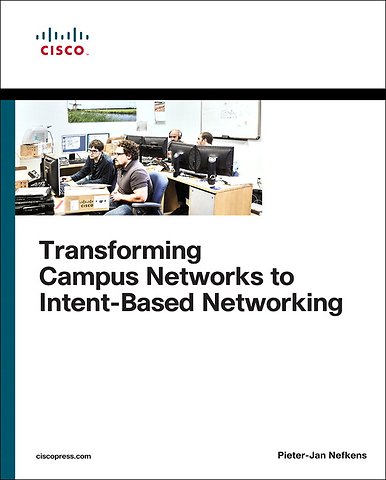Transforming Campus Networks to Intent-Based Networking
Paperback Engels 2019 9780135466339Samenvatting
Intent-Based Networking (IBN) enables you to create networks that capture business intent, automatically activate it across your network, assure that your network has responded properly, proactively detect and contain security threats, and remedy other network issues before users even notice. Intent-based networking makes networks dramatically more valuable, but few organizations have the luxury of building them from the ground up. In this guide, leading IBN expert Pieter-Jans Nefkens presents a unique four-phase approach to preparing and transforming existing network infrastructures, architectures, and organization to gain maximum value from IBN with minimum disruption and cost.
Writing for network consultants, network architects, network designers, and senior network engineers, Nefkens outlines the problems IBN is intended to solve, and illuminates its implications: not only for technical infrastructure but also for network architecture, team management, and culture. Drawing on his pioneering IBN experience, Nefkens makes specific recommendations, identifies pitfalls, and show how to overcome them.
You’ll discover how to implement IBN with Cisco’s Digital Network Architecture and DNA Center, and walk through several real-world use cases: large enterprise networks, worldwide campus networks, mid-sized enterprises, and smaller businesses. Introduces a unique 4-phase methodology for incremental, non-disruptive “brownfield” transformations, since you probably can’t create a new network from the ground up Presents detailed guidance for implementing IBN with Cisco DNA and DNA Center Explains IBN’s crucial implications for managing network teams and evolving culture Contains start-to-finish case study scenarios: large enterprise networks, worldwide campus networks, mid-sized enterprises, and smaller businesses How to migrate today’s networks to intent-based networking — and drive transformative improvements in simplicity, security, management, cost, and agility Introduces a unique 4-phase methodology for incremental, non-disruptive “brownfield” transformations, since you probably can’t create a new network from the ground up Presents detailed guidance for implementing IBN with Cisco DNA and DNA Center Explains IBN’s crucial implications for managing network teams and evolving culture Contains start-to-finish case study scenarios: large enterprise networks, worldwide campus networks, mid-sized enterprises, and smaller businesses
Specificaties
Lezersrecensies
Inhoudsopgave
Rubrieken
- advisering
- algemeen management
- coaching en trainen
- communicatie en media
- economie
- financieel management
- inkoop en logistiek
- internet en social media
- it-management / ict
- juridisch
- leiderschap
- marketing
- mens en maatschappij
- non-profit
- ondernemen
- organisatiekunde
- personal finance
- personeelsmanagement
- persoonlijke effectiviteit
- projectmanagement
- psychologie
- reclame en verkoop
- strategisch management
- verandermanagement
- werk en loopbaan
